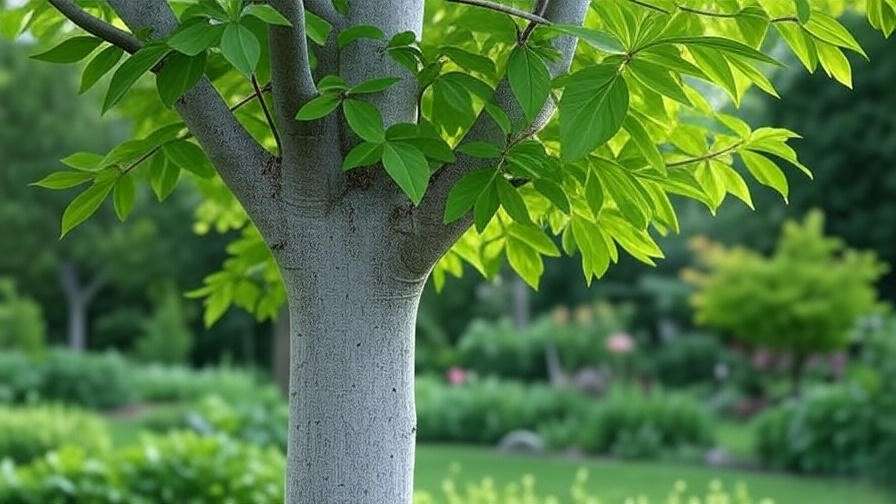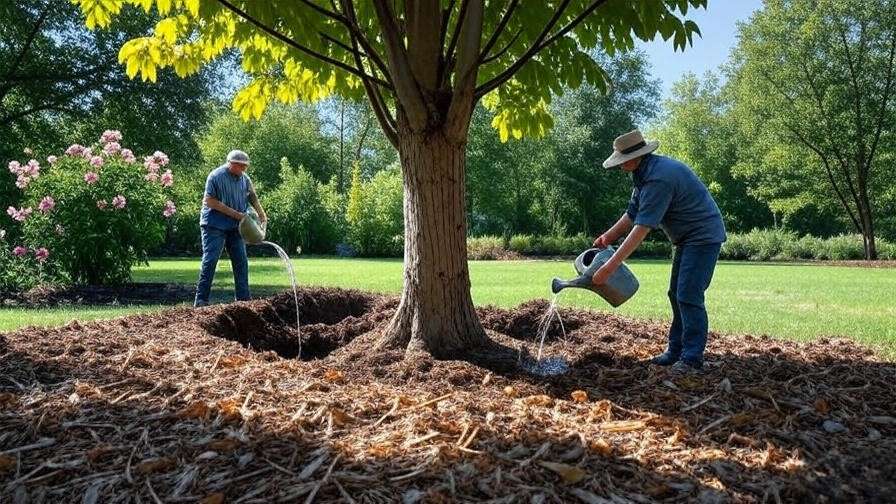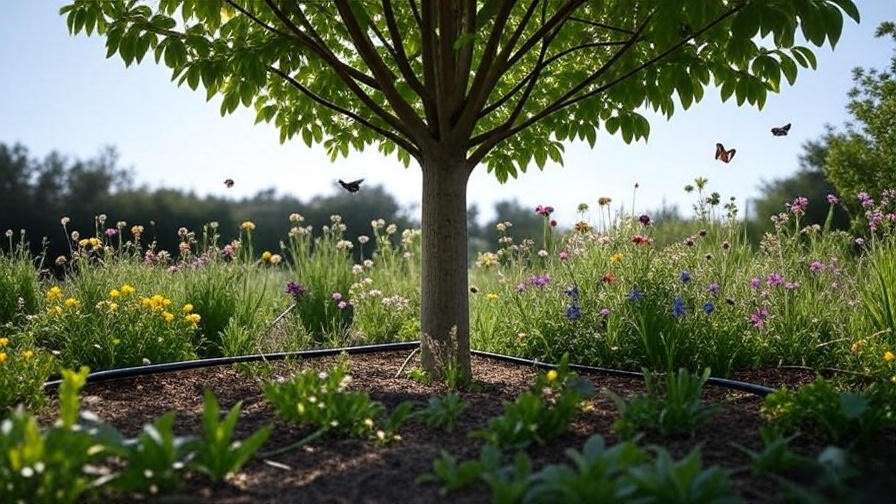Imagine transforming your small garden into a breathtaking oasis with the sleek, upright elegance of a columnar hornbeam tree. Perfect for urban yards or cozy patios, this low-maintenance beauty combines stunning aesthetics with practical space-saving design. Whether you’re a seasoned gardener or a beginner dreaming of a vibrant landscape, the columnar hornbeam tree (Carpinus betulus) offers a solution to elevate your outdoor space. In this comprehensive guide, we’ll walk you through everything you need to know to plant, care for, and maintain a thriving columnar hornbeam, ensuring your garden shines year-round. Backed by expert insights from certified arborists and horticulturists, this article delivers actionable tips to help you succeed. Ready to grow a showstopper? Let’s dig in! 🌿
1. What Is a Columnar Hornbeam Tree? 🌿
1.1 Defining the Columnar Hornbeam
The columnar hornbeam tree, a cultivar of Carpinus betulus, is a deciduous tree prized for its narrow, upright growth habit. Popular varieties like ‘Fastigiata’, ‘Columnaris’, and ‘Frans Fontaine’ feature dense, vibrant green foliage that turns golden-yellow in fall, adding seasonal charm. Unlike traditional broad-canopy trees, columnar hornbeams grow tall (up to 30–40 feet) but stay slim (6–10 feet wide), making them ideal for tight spaces. Their smooth, gray bark and compact form lend a polished look to any landscape, from modern urban gardens to classic estates.

1.2 Benefits of Growing a Columnar Hornbeam
Why choose a columnar hornbeam? Its benefits are hard to beat:
- Space Efficiency: Perfect for small yards, patios, or narrow strips where wider trees won’t fit.
- Aesthetic Appeal: Lush summer leaves, vibrant fall colors, and attractive winter structure.
- Low Maintenance: Requires minimal pruning and care compared to other ornamental trees.
- Environmental Perks: Provides shade, improves air quality, and attracts birds and pollinators.
These qualities make columnar hornbeams a top choice for homeowners seeking beauty without the hassle. Plus, their adaptability to various climates (USDA zones 4–8) ensures success across diverse regions.
2. Choosing the Right Columnar Hornbeam for Your Garden 🪴
2.1 Popular Varieties of Columnar Hornbeam
Not all columnar hornbeams are identical. Here’s a quick comparison of the top varieties:
- ‘Fastigiata’: Grows 30–40 feet tall, 10 feet wide, with a dense, conical shape. Ideal for privacy screens.
- ‘Columnaris’: Slightly shorter (25–30 feet), ultra-narrow (6–8 feet), perfect for tight spaces.
- ‘Frans Fontaine’: Reaches 30 feet, maintains a slender 8-foot width, and is highly adaptable to urban conditions.
Consider your climate, soil, and garden size when choosing. For colder regions (zone 4), ‘Frans Fontaine’ is a resilient pick, while ‘Fastigiata’ thrives in milder climates.
2.2 Where to Source Quality Trees
To ensure a healthy tree, purchase from reputable nurseries or certified suppliers. Look for:
- Healthy Stock: Vibrant leaves, no signs of pests or disease, and a sturdy root ball.
- Certifications: Nurseries accredited by organizations like the American Nursery & Landscape Association.
- Local Options: Sourcing locally ensures the tree is acclimated to your region’s climate.
Expert Insight: “Always inspect the root system before buying,” advises Sarah Thompson, a certified arborist with 20 years of experience. “Healthy roots should be firm, not mushy, and free of rot.”

3. Planting Your Columnar Hornbeam: Step-by-Step Guide 🌲
3.1 Best Time to Plant
Timing is critical for successful planting. Early spring or fall is ideal, as cooler temperatures promote root establishment without stressing the tree. In USDA zones 4–8, aim for:
- Spring: March to May, before leaf-out.
- Fall: September to early November, at least six weeks before the first frost.
Avoid planting during hot summer months or deep winter freezes to prevent transplant shock.
3.2 Site Selection and Preparation
Columnar hornbeams thrive in:
- Sunlight: Full sun (6+ hours daily) to partial shade (4–6 hours). Too much shade can slow growth.
- Soil: Well-drained, loamy soil with a pH of 6.0–7.5. They tolerate clay or sandy soils if amended.
- Space: Allow 6–10 feet between trees for hedges or standalone specimens.
Before planting, test your soil’s pH and drainage. Amend with compost or organic matter to improve fertility and structure. Clear the site of weeds and debris to reduce competition.
3.3 Planting Process
Follow these steps for a successful planting:
- Dig the Hole: Make it twice as wide and as deep as the root ball (e.g., 24 inches wide for a 12-inch root ball).
- Position the Tree: Place the root ball in the hole, ensuring the trunk’s base is level with the ground.
- Backfill: Fill with native soil mixed with compost, tamping gently to remove air pockets.
- Water Thoroughly: Soak the soil to settle roots, adding 1–2 gallons for a young tree.
- Mulch: Apply a 2–3 inch layer of organic mulch (e.g., wood chips) around the base, keeping it 2 inches from the trunk.
Pro Tip: Stake young trees in windy areas to stabilize them for the first year.

4. Essential Care Tips for a Thriving Columnar Hornbeam 🌞
4.1 Watering Needs
Proper watering is key to a healthy hornbeam:
- First Year: Water deeply (1–2 gallons) twice weekly during dry spells to establish roots.
- Mature Trees: Water once weekly during drought; otherwise, natural rainfall often suffices.
- Signs of Trouble: Yellowing leaves may indicate overwatering; wilting suggests underwatering.
Use a soaker hose or drip irrigation for efficient watering, avoiding overhead sprinklers to prevent foliar diseases.
4.2 Fertilizing for Optimal Growth
Hornbeams don’t need heavy feeding but benefit from balanced nutrition:
- Type: Use a slow-release, balanced fertilizer (e.g., 10-10-10 NPK) or organic compost.
- Timing: Apply in early spring before new growth begins.
- How Much: Follow package instructions, typically 1–2 pounds per tree for young specimens.
Expert Tip: “Test your soil annually to avoid over-fertilizing, which can burn roots,” says Dr. Emily Carter, a horticulturist specializing in ornamental trees.
4.3 Pruning and Shaping
Pruning maintains the columnar shape and promotes health:
- When: Prune in late winter or early spring before bud break.
- How: Remove dead, damaged, or crossing branches using clean, sharp shears. Trim lightly to preserve the natural form.
- Tools: Use bypass pruners for small branches and loppers for thicker ones.
- Mistakes to Avoid: Over-pruning can stress the tree; never remove more than 25% of the canopy at once.
4.4 Mulching and Soil Care
Mulching protects roots and conserves moisture:
- Materials: Use organic mulch like bark, wood chips, or shredded leaves.
- Application: Apply a 2–3 inch layer annually, keeping it away from the trunk to prevent rot.
- Benefits: Reduces weeds, regulates soil temperature, and retains moisture.
Refresh mulch yearly and check soil drainage to prevent waterlogging.
5. Common Challenges and Solutions 🐛
5.1 Pests and Diseases
While hardy, columnar hornbeams can face issues:
- Pests:
- Aphids: Small sap-suckers causing leaf curl. Control with insecticidal soap or neem oil.
- Scale Insects: Hard-shelled pests on branches. Use horticultural oil in early spring.
- Spider Mites: Cause stippling on leaves. Increase humidity and spray with water.
- Diseases:
- Powdery Mildew: White coating on leaves. Improve air circulation and apply fungicides if severe.
- Leaf Spot: Dark spots on foliage. Remove affected leaves and avoid overhead watering.
- Canker: Sunken bark areas. Prune infected branches and disinfect tools.
Use organic controls first, resorting to chemicals only when necessary, and follow label instructions.

5.2 Environmental Stressors
Hornbeams are resilient but sensitive to extremes:
- Drought: Mulch and water deeply during dry spells.
- Frost: Wrap young trees in burlap during late spring frosts in colder zones.
- Wind: Stake young trees and plant in sheltered locations to prevent tipping.
Case Study: A homeowner in Zone 5 revived a drought-stressed hornbeam by adding drip irrigation and mulching heavily, restoring vibrant growth within one season.
5.3 Troubleshooting Growth Issues
Common problems and fixes:
- Yellowing Leaves: Check for overwatering, nutrient deficiency, or poor drainage. Adjust watering and fertilize if needed.
- Stunted Growth: Ensure adequate sunlight and test soil for compaction or nutrient imbalances.
- Sparse Foliage: Prune to improve air circulation and check for pests.
Consult a certified arborist if issues persist beyond basic care adjustments.
6. Designing with Columnar Hornbeam Trees in Your Landscape 🎨
6.1 Creative Uses in Garden Design
The columnar hornbeam tree is a versatile star in landscape design, offering endless possibilities for both aesthetic and functional purposes. Its slim profile and lush foliage make it a favorite for homeowners and landscape architects alike. Here are some creative ways to incorporate it into your garden:
- Privacy Hedges: Plant a row of columnar hornbeams 6–8 feet apart to create a natural, evergreen-like screen that blocks nosy neighbors while adding elegance. Their dense foliage ensures year-round privacy, even in winter when leaves persist in some climates.
- Allees and Pathways: Line walkways or driveways with ‘Fastigiata’ or ‘Frans Fontaine’ for a formal, European-inspired look. This creates a grand entrance that’s both inviting and structured.
- Focal Points: Use a single columnar hornbeam as a striking centerpiece in small yards or courtyards. Its vertical form draws the eye upward, adding height without crowding the space.
- Container Planting: For patios or urban balconies, grow ‘Columnaris’ in large containers (at least 24 inches wide) to bring greenery to paved areas. Ensure proper drainage and regular watering.
Companion Planting Tip: Pair hornbeams with low-growing perennials like hostas, ferns, or lavender for a balanced look. These plants complement the tree’s upright form without competing for space. For a pop of color, add seasonal annuals like impatiens or marigolds at the base.
6.2 Seasonal Interest and Maintenance
One of the columnar hornbeam’s greatest strengths is its year-round appeal:
- Spring: Fresh green leaves emerge, paired with subtle catkins that attract pollinators.
- Summer: Dense foliage provides cooling shade and a lush backdrop for garden activities.
- Fall: Leaves turn a vibrant golden-yellow, creating a warm, autumnal glow.
- Winter: The tree’s smooth gray bark and persistent leaves (in milder climates) add structural interest.
To maintain this seasonal beauty with minimal effort:
- Refresh mulch annually to protect roots and enhance soil health.
- Lightly prune in late winter to maintain the desired shape.
- Monitor for pests or diseases during humid summer months.
Design Tip: Combine hornbeams with evergreen shrubs like boxwood or yew for a dynamic contrast in texture and color, ensuring your garden stays visually appealing even in winter.
7. Long-Term Care and Sustainability 🌍
7.1 Ensuring Longevity
With proper care, columnar hornbeam trees can thrive for 50 years or more, becoming a lasting feature of your landscape. To promote longevity:
- Regular Inspections: Check annually for signs of stress, such as cracked bark, wilting leaves, or pest activity. Early detection prevents minor issues from escalating.
- Soil Health: Maintain fertile, well-drained soil by adding organic matter (e.g., compost) every 2–3 years.
- Water Management: Once established, hornbeams are drought-tolerant, but consistent watering during prolonged dry spells ensures robust health.
Expert Insight: “Long-term success comes from treating your tree as a living investment,” says Dr. Michael Rivera, a landscape ecologist with 25 years of experience. “Regular care and attention to environmental changes can extend its life significantly.”
7.2 Eco-Friendly Practices
Columnar hornbeams are not only beautiful but also environmentally friendly. Here’s how to maximize their ecological benefits:
- Water Conservation: Install a drip irrigation system to deliver water directly to the root zone, reducing waste. Alternatively, collect rainwater in barrels for sustainable watering.
- Wildlife Support: Hornbeams attract birds (e.g., finches) and beneficial insects like bees, enhancing local biodiversity. Avoid chemical pesticides to protect these visitors.
- Carbon Sequestration: Like all trees, hornbeams absorb carbon dioxide, helping mitigate climate change. A single mature tree can sequester up to 48 pounds of CO2 annually.
Pro Tip: Create a pollinator-friendly garden by planting native wildflowers near your hornbeam. This boosts ecosystem health and adds visual charm.

8. FAQs About Columnar Hornbeam Trees ❓
To address common reader questions and boost SEO, here are answers to frequently asked questions about columnar hornbeam trees, based on expert knowledge and practical experience:
- How fast do columnar hornbeams grow?
Columnar hornbeams grow moderately, adding 12–18 inches per year under optimal conditions. Growth slows after 10–15 years as the tree reaches maturity. - Can they grow in containers?
Yes, varieties like ‘Columnaris’ thrive in large containers with proper care. Use a well-draining potting mix and water regularly, as containers dry out faster than ground soil. - Are they deer-resistant?
Hornbeams are moderately deer-resistant, as deer tend to avoid their tough leaves. However, in areas with high deer populations, consider protective netting for young trees. - What’s the difference between ‘Fastigiata’ and ‘Frans Fontaine’?
‘Fastigiata’ has a broader, conical shape (10 feet wide), while ‘Frans Fontaine’ is narrower (6–8 feet) and better suited for tight spaces or urban settings. - How do I prevent leaf drop in summer?
Leaf drop may signal underwatering, pests, or poor drainage. Check soil moisture, inspect for aphids or spider mites, and ensure proper drainage to address the issue.
9. Conclusion: Why the Columnar Hornbeam Is Your Next Must-Have Tree 🌟
The columnar hornbeam tree is a game-changer for homeowners seeking a low-maintenance, space-saving, and visually stunning addition to their landscape. Its elegant form, vibrant seasonal changes, and environmental benefits make it a standout choice for urban gardens, small yards, or privacy screens. By following this guide—crafted with insights from certified arborists and horticulturists—you’re equipped to plant, care for, and enjoy a thriving hornbeam for decades to come.
Ready to transform your garden? Start by selecting a healthy columnar hornbeam and following our step-by-step planting and care tips. Have a success story or question? Share it in the comments below or join a local gardening community for ongoing inspiration and support. Your dream landscape is just a tree away! 🌳













